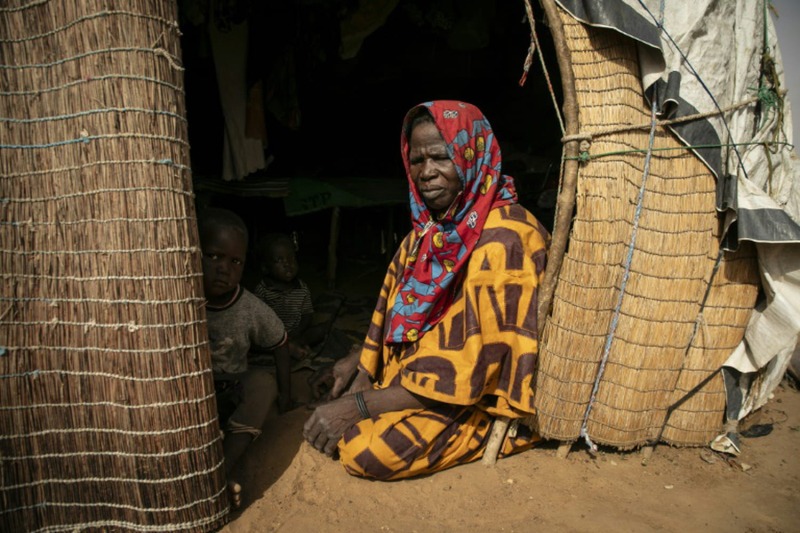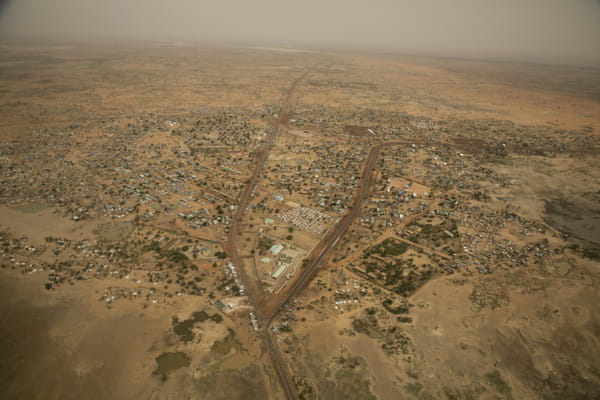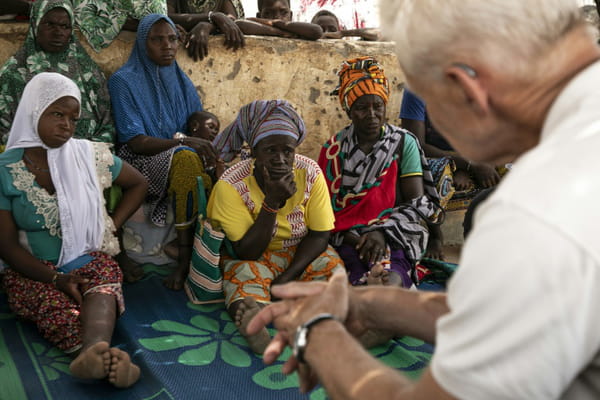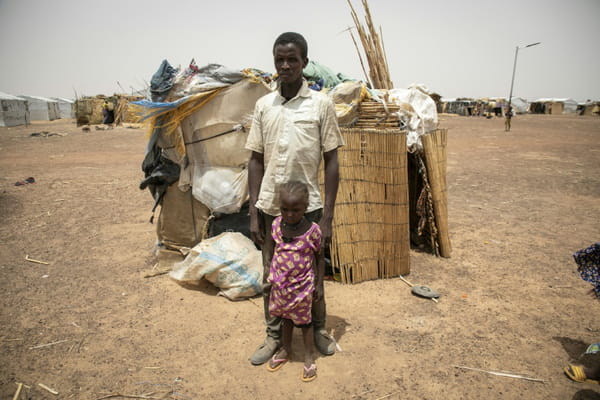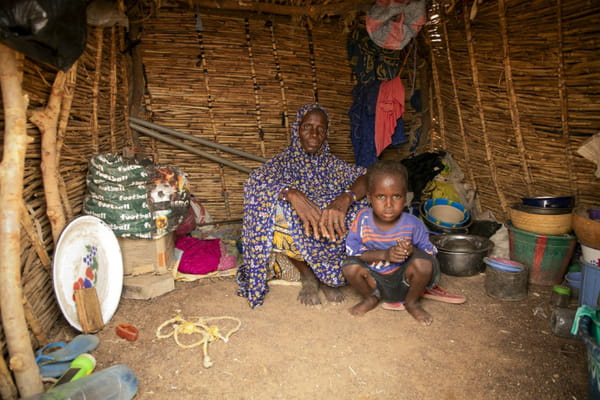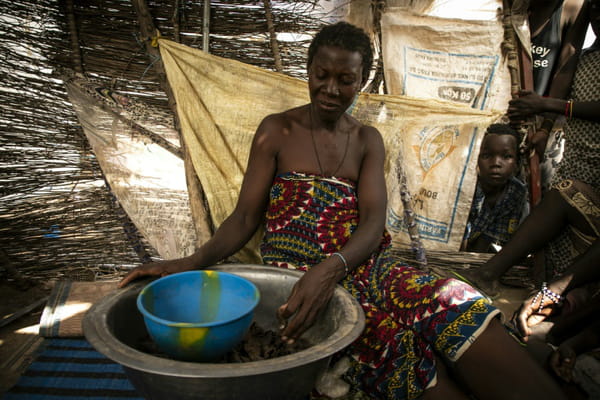Below 43 degrees, a few meager trees struggle to survive. shade the tents and makeshift shelters in the camps near Dori. In the north-east of Burkina Faso, thousands of displaced people have fled jihadist violence, towards these precarious refuges where there are many people. their future seems hopeless. In the Wendou 2 camp – an extension of the immense eponymous camp which alone houses some 3,000 displaced people – Hawa Mama admits to having “no longer even the strength to move”. “Even if it's difficult here, there (in the villages, editor's note) it's worse. We have no other choice but to stay here. We have nothing left there, we came here, we have to stay in these conditions,” says this fifty-year-old in Fulfulde, the language of the Fulani ethnic group, with a red loincloth covering her head. Kirissi Sawadogo also fled his village of Lélly, in the Sahel region, to save his life. “It's because of the situation the country is going through. They came to our village, they threatened us, they stole our livestock, they killed people. That's why we had to flee and that we arrived here”, she explains to AFP, crumbling tô brulé, a paste made from millet flour. Aerial view of Dori, in northeastern Burkina Faso, May 29, 2024 © AFP – FANNY NOARO-KABRÉ Rarely named by the displaced, these armed men are generally jihadist fighters, linked to Al-Qaeda or the Islamic State, who have been terrorizing populations with bloody attacks for nearly 10 years in Burkina Faso. The Sahel region is paying a heavy price: a quarter of the two million internally displaced people in Burkina Faso come from there, according to official figures from March 2023 which have not been not been updated since. The Wendou camp was even attacked in September 2023 and at least 8 displaced people were killed. At the start of the year, 85% of schools and 69% of health infrastructure in the Sahel region were closed, according to the Office for the Coordination of Humanitarian Affairs of the United Nations (OCHA). – “Relying on ourselves” – According to a ranking by the Norwegian Refugee Council (NRC) published on Monday, Burkina Faso is experiencing the most neglected displacement crisis in the world, for the second year in a row. “The Sahel is a region that is systematically neglected”, underlines Jan Egeland, secretary general of the NRC, visiting the camps near Dori at the end of May. Secretary General of the Norwegian Refugee Council Jan Egeland speaks with displaced people at the Torodi camp in Dori, northeastern Burkina Faso, May 30, 2024 © AFP – FANNY NOARO-KABRÉ “And now, on top of that, there is a diplomatic and political crisis between donors in Europe and the West, and the new military governments, across the Sahel,” he continues. Burkina Faso is governed, like its neighbors Mali and Niger, also prey to jihadist violence, by a military regime, which came to power through a coup. State in 2022 and whose relations with Western powers – in particular France – are tumultuous. The authorities regularly claim to obtain victories over the jihadists, but the attacks continue and part of the territory remains beyond the control of the army. “We are right there, with nothing, we have to rely on ourselves to survive”, laments Amadou Dicko, who arrived 6 months ago with his family in Torodi , another camp near Dori, where the desolate landscape is the same as in Wendou. Amadou Dicko and his daughter, who fled their village to take refuge in Dori, in the northeast of Burkina Faso, on May 29, 2024 in the Torodi camp © AFP – FANNY NOARO-KABRÉ To earn a few thousand CFA francs, some men do illegal gold panning in the surrounding area, despite the security risks. Sitting on a mat on the ground, in a shelter of approximately 3 square meters made of secco (a plant fence), wood and tarpaulins, Aissetou Amadou arrived at the same time. < p>With her family, she had to flee her village, located near Gorgadji, threatened by “armed men”. “It's the children who are trying to bring back food. Yesterday they were able to bring back 2 kilos of rice (purchased in town). We cooked half in the evening and the rest this morning,” she says, without knowing when it will be. possible the next refueling. – Risky supply – Aissetou Amadou, 52, on May 29, 2024 in the Torodi displaced persons camp with one of her children, in Dori, in the northeast of Burkina Faso © AFP – FANNY NOARO-KABRÉ A large city in northeastern Burkina Faso, close to the National Road 3 leading to Ouagadougou, Dori is a nerve center for supplying the region. But while humanitarian aid for essential needs arrives by air via World Food Program (WFP) flights, food, gasoline, and necessary agricultural inputs still go by road, under army escort. On the edge of the RN 3, dozens of trucks are parked, waiting for the green light to leave in convoy, on this dangerous section, regularly targeted by the jihadists who are on the very outskirts of Dori. “Before, you could load your vehicle at 7 p.m. in Ouagadougou, at the latest, at 5 or 6 a.m. the next day the vehicle was in front of your shop,” relates Amadou Hamidou Dicko, president of the Dori traders. “Currently, we have to wait 15, 30 or 45 days, it depends, because we never communicate the exact day the convoy starts”, he says. Consequence: the delivery cost has increased and is reflected in sales prices. “Two or three years ago, the bag of 50 kg rice sold between 16,000 and 17,000 CFA francs (24-25 euros) Currently it is 27,000 CFA francs (41 euros),” explains Mr. Dicko. So sometimes, traders opt for what they call “the bypass”, via other routes, unescorted, at the risk of seeing goods and trucks stolen or destroyed. Kirissi Sawadogo prepares food on May 30, 2024 in the Wendou 2 refugee camp in Dori, northeastern Burkina Faso © AFP – FANNY NOARO-KABRÉ At the Wendou camp, Kirissi Sawadogo finishes crumbling the tô. That evening, she will add a little water and salt and feed it to her children. All rights of reproduction and representation reserved. © (2024) Agence France-Presse